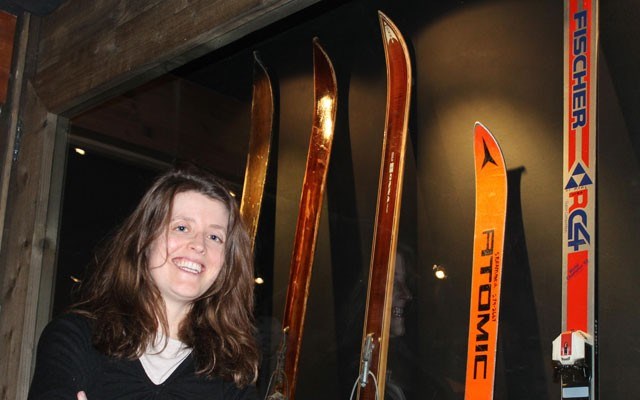So the first ski we have here is one of Myrtle Philip's skis... they're edgeless, wooden skis."
The executive director of the Whistler Museum and Archives, Sarah Drewery, points to a brown plank-like object that looks like it could have been ripped from a door and sanded down a bit.
This isn't true but there is no doubting that Philip, who came to the valley just over 100 years ago and founded Rainbow Lodge on Alta Lake, had to make do with some low-tech travelling implements compared to the aerodynamic, lightweight, branded objects of beauty we see flying around the slopes these days.
Philip's ski is one of around 100 pair of skis and snowboards collected by the museum over the years. They were unable to be displayed until mid-November, when the new Evolution of Skiing exhibit opened following renovation.
The exhibit includes a new three-metre high glass case which finally allows the history of Whistler skiing and snowboarding to be put on display, although it only fits around 10 skis or snowboards and means the collection must be rotated in order to be seen.
Whatever the limitations, Drewery said that prior to this, only a child's pair of skis would fit in the small cases.
"It's great to have skis from our major historical figures to Whistler, and other skis and the snowboards show the evolution of the technology," Drewery says.
"Visitors like to hear the stories and then see something that belonged to the people they are hearing about. Just 50 years ago, things were so different. The change in this town is incredible."
The collection has grown "because people have donated skis and snowboards over the years."
In a 1970 interview, Philip told a story from the winter of 1915 where she helped a team of engineers who had been working in Pemberton. She fed them for two days and allowed them to stay at Alta Lake, putting on her "very good pair of skis" to guide them to a train from Squamish that had reached the Cheakamus Canyon to meet them. Her skis were strictly for cross-country travel.
"One old engineer... I don't think he'd ever walked for a mile in his life... and he was having great difficulty in walking out on the home-made skis that they'd made at Pemberton to travel over the snow..."
Drewery hastens to add that there is no way of knowing if the ski in the glass case is the same one from Philip's story, but to have such an object as a ski belonging to such a pioneer of the community really brings that era and Whistler's founding to life.
Philip, upon her death, bequeathed the skis and many other items to museum founder Florence Petersen. The museum was founded in 1986 and her skis launched the ski and snowboard collection.
The collection also includes a set of skis belonging to Franz Wilhelmsen, the founder of Whistler Mountain. They come from the era when he was looking north of Vancouver for a good location to establish a ski resort for the 1968 Winter Olympics, following the inspiration of the Squaw Valley Winter Olympics of 1960.
"They pre-date the 1960s and they could have been used when he was scouting out the area and looking for a new mountain (to develop). Franz was helicoptered in and... that is how it was discovered," Drewery said.
The Diamond Head near Squamish was considered, but in the end Whistler won, and was opened as a resort in 1965. This was when downhill skiing took over from cross-country as the sport of the region.
And, of course, it took until 2010 for the Winter Games to finally come here.
A single, absurd-looking "mono-ski" has a pride of place between the early skis and snowboards. Drewery describes it as being like a branch of the evolutionary tree that has gone extinct.
A split board from 2009 by local snowboard makers Prior is also in the case, as is a Burton board that by today's standards looks like a giant.
"We wanted to show a split board because people from outside this community do not necessarily know even what a split board is and that they exist. If you are not into the ski scene here you probably don't know they exist," she said.
Drewery says it would be "amazing to have a bigger museum" in order to display more of their collection.
"We could display more things, whether they are skis or not. One of the items is a huge wooden sign that once was for the ski school right in the beginning. It used to hang next to a huge bell from a church... it was an iconic symbol for Whistler," she says.
"When people think of skiing here in the '60s they will remember the bell and sign. The sign is huge and is out on loan to the Four Seasons, hanging there. It's the same with Myrtle Philip's canoe, which hangs in the library. It looks great but it would be great to gather everything together."




